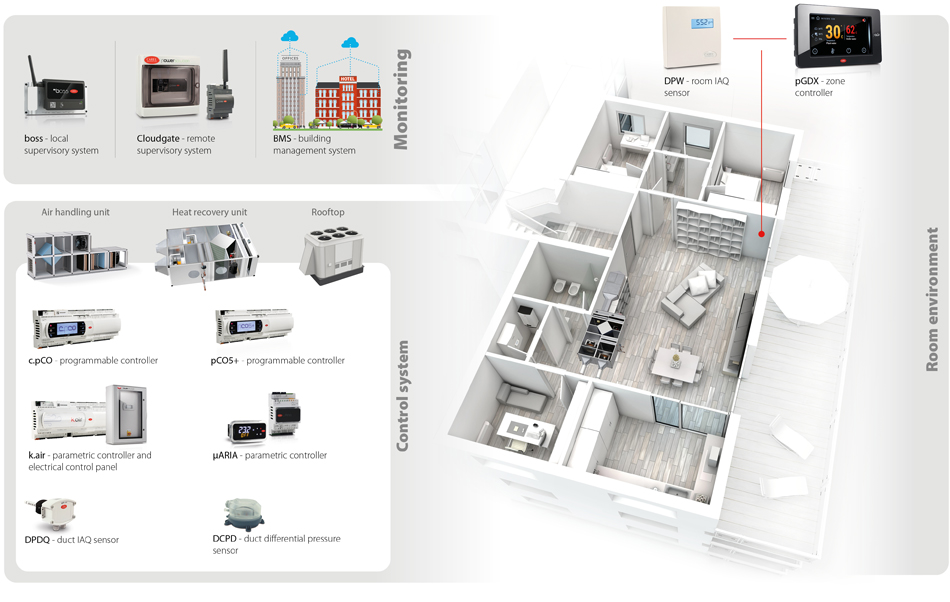Poprawa jakości powietrza w pomieszczeniach dzięki nowym czujnikom CAREL

 Czyste powietrze jest podstawowym wymogiem życia: jakość powietrza wewnątrz domów, biur, szkół, budynków publicznych, placówek służby zdrowia [...] jest istotnym czynnikiem decydującym o zdrowym życiu i dobrostanie ludzi.
Czyste powietrze jest podstawowym wymogiem życia: jakość powietrza wewnątrz domów, biur, szkół, budynków publicznych, placówek służby zdrowia [...] jest istotnym czynnikiem decydującym o zdrowym życiu i dobrostanie ludzi.

- WHO Guidelines for Indoor Air Quality – selected pollutants -
 Średnio 90% naszego życia spędzamy w zamkniętych budynkach
.
Średnio 90% naszego życia spędzamy w zamkniętych budynkach
.
- A Resource for Assessing Exposure to Environmental Pollutants (2001) -
- The National Human Activity Pattern Survey (NHAPS) -
 30% nowych i przebudowanych budynków może mieć problemy z jakością powietrza w pomieszczeniach.
30% nowych i przebudowanych budynków może mieć problemy z jakością powietrza w pomieszczeniach.
- United States Environmental Protection Agency (EPA) -
Teraz dla każdego jest jasne, jak ważna jest jakość powietrza, którym oddychamy każdego dnia w naszych domach i biurach.
Rzeczywiście, istnieje silna korelacja między poziomami różnych parametrów środowiskowych a naszym komfortem i zdrowiem. Utrzymywanie parametrów takich jak temperatura, wilgotność względna, CO2, VOC i PM w optymalnym zakresie poprawia komfort i produktywność, drastycznie zmniejsza prawdopodobieństwo przenoszenia chorób przenoszonych drogą powietrzną i wzmacnia obronę naszego układu oddechowego.
Parametry pomiaru jakości powietrza w pomieszczeniach
Temperatura
 Temperatura to parametr fizyczny, który odnosi się do odczuć ciepła i zimna, i wyraża energię cieplną obiektów. Dla osobistego komfortu temperatura w pomieszczeniu powinna wynosić od 67 do 82°F lub od 20 do 27°C przez cały rok.
Temperatura to parametr fizyczny, który odnosi się do odczuć ciepła i zimna, i wyraża energię cieplną obiektów. Dla osobistego komfortu temperatura w pomieszczeniu powinna wynosić od 67 do 82°F lub od 20 do 27°C przez cały rok.
Wilgotność względna
 Wilgotność względna to stosunek pary wodnej obecnej w powietrzu do maksymalnej ilości, jaką to samo powietrze może pomieścić, zanim wytrąci się. Ludzkie ciało najlepiej reaguje w zakresie wilgotności względnej od 40 do 60%.
Wilgotność względna to stosunek pary wodnej obecnej w powietrzu do maksymalnej ilości, jaką to samo powietrze może pomieścić, zanim wytrąci się. Ludzkie ciało najlepiej reaguje w zakresie wilgotności względnej od 40 do 60%.
Stężenie CO2
 Dwutlenek węgla jest bezbarwnym i bezwonnym gazem powstającym w wyniku spalania i oddychania człowieka. Występuje naturalnie w powietrzu (0,03%) i jest wchłaniany przez rośliny poprzez fotosyntezę. Często jest mierzony w pomieszczeniach jako wskaźnik obecności ludzi, przy czym wysoki poziom CO2 wymaga zwiększenia wentylacji. Zalecane wartości dla środowisk wewnętrznych wynoszą poniżej 1000 ppm.
Dwutlenek węgla jest bezbarwnym i bezwonnym gazem powstającym w wyniku spalania i oddychania człowieka. Występuje naturalnie w powietrzu (0,03%) i jest wchłaniany przez rośliny poprzez fotosyntezę. Często jest mierzony w pomieszczeniach jako wskaźnik obecności ludzi, przy czym wysoki poziom CO2 wymaga zwiększenia wentylacji. Zalecane wartości dla środowisk wewnętrznych wynoszą poniżej 1000 ppm.
Stężenie VOC
 Lotne związki organiczne (LZO) to organiczne składniki chemiczne odpowiedzialne za obecność zapachów i niektórych zanieczyszczeń. Poziomy wewnątrz pomieszczeń są zwykle znacznie wyższe niż na zewnątrz, ze względu na nadmierne stosowanie chemikaliów i detergentów do czyszczenia. Długotrwałe narażenie na te chemikalia może powodować podrażnienia, bóle głowy, a niektóre mogą być nawet rakotwórcze. Zalecane wartości dla środowisk wewnątrz pomieszczeń są poniżej 300 ppb.
Lotne związki organiczne (LZO) to organiczne składniki chemiczne odpowiedzialne za obecność zapachów i niektórych zanieczyszczeń. Poziomy wewnątrz pomieszczeń są zwykle znacznie wyższe niż na zewnątrz, ze względu na nadmierne stosowanie chemikaliów i detergentów do czyszczenia. Długotrwałe narażenie na te chemikalia może powodować podrażnienia, bóle głowy, a niektóre mogą być nawet rakotwórcze. Zalecane wartości dla środowisk wewnątrz pomieszczeń są poniżej 300 ppb.
Stężenie PM
 Cząstki stałe obejmują zestaw stałych i/lub ciekłych cząstek zawieszonych w powietrzu, generowanych przez takie czynności jak gotowanie, dym papierosowy i inne źródła spalania, a także drukarki. Najdrobniejsze cząstki są w stanie wniknąć głęboko do płuc. Zalecane wartości dla środowisk wewnętrznych wynoszą poniżej 10 μg/m3 dla PM2,5 i poniżej 20 μg/m3 dla PM10.
Cząstki stałe obejmują zestaw stałych i/lub ciekłych cząstek zawieszonych w powietrzu, generowanych przez takie czynności jak gotowanie, dym papierosowy i inne źródła spalania, a także drukarki. Najdrobniejsze cząstki są w stanie wniknąć głęboko do płuc. Zalecane wartości dla środowisk wewnętrznych wynoszą poniżej 10 μg/m3 dla PM2,5 i poniżej 20 μg/m3 dla PM10.
Stąd decyzja firmy CAREL o wprowadzeniu na rynek udoskonalonej gamy czujników jakości powietrza.

Wszystkie nowe czujniki są wyposażone w komunikację szeregową, aby uprościć instalację i podłączenie, i są dostępne w wersji ściennej lub kanałowej, z wyświetlaczem lub bez. Dostępna jest również wersja 5 w 1, która obejmuje czujniki temperatury, wilgotności względnej, CO2, VOC i PM w jednym produkcie, aby poprawić estetykę i zmniejszyć koszty instalacji.
Niezależnie od tego, czy chodzi o modernizację, czy instalację w nowym budynku, prawidłowe zarządzanie jakością powietrza w pomieszczeniach jest kolejnym poważnym wyzwaniem w branży klimatyzacyjnej, równolegle z efektywnością energetyczną. Oprócz czujników, CAREL może również zaoferować kompletne rozwiązanie do monitorowania i kontrolowania jakości powietrza.

